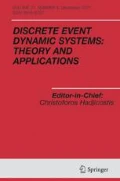Abstract
Based on a rearrangement inequality by Hardy, Littlewood, and Polya, we define two-operator algebras for independent random variables. These algebras are called Huffman algebras since the Huffman algorithm on these algebras produces an optimal binary tree that minimizes the weighted lengths of leaves. Many examples of such algebras are given. For the case with random weights of the leaves, we prove the optimality of the tree constructed by the power-of-2 rule, i.e., the Huffman algorithm assuming identical weights, when the weights of the leaves are independent and identically distributed.
Similar content being viewed by others
References
Barlow, R.E., and Proschan, F. 1988.Statistical Theory of Reliability and Life Testing Probability Models. New York: Holt, Reinhart and Winston.
Brown, M., and Solomon, H. 1973. Optimal issuing policies under stochastic field lives.J. Appl. Probab. 10, pp. 761–768.
Campbell, L.L. 1966. Definition of entropy by means of a coding problem.Z. Wahrsch. verw. Gebiete 6, pp. 113–118.
Chang, C.S. 1992. A new ordering for stochastic majorization: theory and applications.Adv. Appl. Probab. 24, pp. 604–634.
Chang, C.S. and Thomas, J.A. 1992. Huffman algebras for independent random variables.IBM RC 17524.
Chang, C.S., and Yao, D.D. 1993. Rearrangement, majorization and stochastic scheduling.Math. Oper. Res., 18, pp. 659–684
Glassey, C.R., and Karp, R.M. 1976. On the optimality of Huffman trees.SIAM J. Appl. math. 31, pp. 368–378.
Golumbic, M.C. 1976. Combinatorial merging.IEEE Trans. Comput. C-25, pp. 1164–1167.
Hardy, G.H., Littlewood, J.E., and Polya, G. 1952.Inequalities. London and New York: Cambridge University Press.
Hu, T.C., Kleitman, D. and Tamaki, J.K. 1979. Binary trees optimum under various criteria.SIAM J. Appl. Math. 37, pp. 246–256.
Hu, T.C., and Tucker, A.C. 1971. Optimal computer search trees and variable length alphabetic codes.SIAM J. Appl. Math. 21, pp. 514–532.
Huffman, D.A. 1952. A method for the construction of minimum redundancy codes.Proc. IRE 40, 1098–1101.
Humblet, P.A. 1981. Generalization of Huffman coding to minimize the probability of buffer overflow.IEEE Trans. Inform. Theory IT-27, pp. 230–232.
Hwang, F.K. 1979. Generalized Huffman trees.SIAM J. Appl. Math. 37, pp. 124–127.
Itai, A. 1976. Optimal algebraic trees.SIAM J. Comput. 5, pp. 9–18.
Keilson, J., and Sumita, U. 1982. Uniform stochastic ordering and related inequalities.The Can. J. Statist. 10, pp. 181–198.
Knuth, D.E. 1982. Huffman's algorithm via algebra.J. Combin. Theory Ser. A 32, pp. 216–224.
Marshall, A.W., and Olkin, I. 1979.Inequalities: Theory of Majorization and Its Applications. San Diego: Academic Press.
Parker, D.S. 1979. Combinatorial merging and Huffman's algorithm.IEEE Trans. Comput. TC-28, pp. 365–367.
Parker, D.S. 1980. Conditions for optimality of the Huffman algorithm.SIAM J. Comput. 9, pp. 470–489.
Renyi, A. 1961. On measuresof entropy and information.Proc. Fourth Berkeley Symp. Math. Statist. Probability I, pp. 547–561.
Ross, S.M. 1983.Stochastic Processes. New York: Wiley.
Shanthikumar, J.G., and Yao, D.D. 1991. Bivariate characterization of some stochastic order relations.Adv. Appl. Probab. 23, pp. 642–659.
Stoyan, D. 1983.Comparison Methods for Queues and Other Stochastic Models. New York: Wiley.
Weber, R.R., Varaiya, P., and Walrand, J. 1986. Scheduling jobs with stochastically ordered processing times on parallel machines to minimize expected flowtime.J. Appl. Probabl. 23, pp. 841–847.
Author information
Authors and Affiliations
Rights and permissions
About this article
Cite this article
Chang, CS., Thomas, J.A. Huffman algebras for independent random variables. Discrete Event Dyn Syst 4, 23–40 (1994). https://doi.org/10.1007/BF01516009
Received:
Revised:
Issue Date:
DOI: https://doi.org/10.1007/BF01516009



